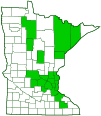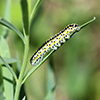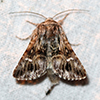Toadflax brocade moth
(Calophasia lunula)
Conservation • Description • Habitat • Ecology • Distribution • Taxonomy
| Hodges # | 10177 |
||
Conservation Status |
|||
| IUCN Red List | not listed |
||
| NatureServe | NNA - Not applicable |
||
| Minnesota | not listed |
||
Description
Toadflax brocade moth is an exotic, medium-sized moth. It is native to Europe and Asia. In Canada, it was first introduced in 1962 at Belleville, Ontario, in an attempt to control invasive butter and eggs (Linaria vulgaris). In the United States, it was first introduced in 1968 near Missoula, Montana. Since those initial introductions, it has been release several times in both countries. It now occurs across southern Canada. In the U.S., it now occurs in the east from Maine to Virginia, west to Minnesota and Illinois, and in the west from Washington State east to Montana and Colorado.
Toadflax brocade moth is found in fields, roadsides, and waste places, wherever its host plant is found. Adults fly from June to August in Minnesota. They are active at night and will come to lights. The larvae are foodplant specialists and are found on toadflax plants (Linaria spp.). They feed on the leaf buds, flower buds, stems, leaves, and flowers.
Adults are 9⁄16″to ⅝″ (14 to 17 mm) in length and have a 1″ to 1¼″ (26 to 32 mm) wingspan. Moth size is sometimes given in terms of forewing length, which in this case is ½″ (12 to 13 mm).
There is a tuft of hair-like scales forming a tall crest on the front of the thorax and another at the rear of the thorax.
The forewing background color is grayish brown, pale brown, or tan, with dark areas, white patches, and black dashes. It is darkest in the median and subterminal areas, and there is a dark medial line. The circular spot in the upper median area (orbicular spot) is small and narrowly oval. It is filled with white and bordered with a thin black line. The spot in the upper median area between the orbicular spot and the inner margin (claviform spot) is white, narrow, and long. A black basal dash ends in the claviform spot. The kidney-shaped spot in the lower median area (reniform spot) is white and bordered with but much larger and almost bar-shaped. There is a pale or whitish, crescent-shaped mark between the reniform spot and the inner margin. The subterminal area has a row of black dashes and white patches. The fringe is checkered grayish brown and white.
Size
Total length: 9⁄16″to ⅝″ (14 to 17 mm)
Forewing length: ½″ (12 to 13 mm)
Wingspan: 1″ to 1¼″ (26 to 32 mm)
Similar Species
Habitat
Fields, roadsides, and waste places
Ecology
Season
Two generations per year:
Behavior
Adults are active at night and will come to lights. They hold their wings tight to the body when at rest.
Life Cycle
Larva Food/Hosts
Leaf buds, flower buds, stems, leaves, and flowers.
Adult Food
Flower nectar
Distribution |
||
|
Sources |
|
| 10/21/2025 | ||
Occurrence |
||
|
||
Taxonomy
Order
Lepidoptera (Butterflies and Moths)
Superfamily
Noctuoidea (owlet moths and allies)
Family
Noctuidae (cutworm moths and allies)
Subfamily
Oncocnemidinae
Genus
Calophasia
Subordinate Taxa
Calocampa lunula
Calophasia anatolica
Calophasia atrifascia
Calophasia atrivestis
Calophasia bilunulata
Calophasia cana
Calophasia extensa
Calophasia linariae
Calophasia melanotica
Calophasia nigrata
Calophasia stempfferi
Calophasia tangens
Cleophana linariae
Noctua linariae
Phalaena lunula
Synonyms
Common Names
toadflax brocade
toadflax brocade moth
Glossary
Claviform spot
A club-shaped, wedge-shaped, or round spot in the upper median area, between the orbicular spot and the inner margin, connected to the AM line, on the forewing of many moths.
Orbicular spot
A circular spot or outline in the upper median area near the antemedial line on the forewing of many moths.
Reniform spot
A kidney-shaped spot or outline in the lower median area near the PM line on the forewing of many moths.
Visitor Photos
Share your photo of this insect.
This button not working for you?
Simply email us at info@MinnesotaSeasons.com.
Attach one or more photos and, if you like, a caption.
Gary Walton |
||
from Carlton County: Calophasia lunula. |
||
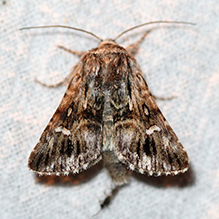 |
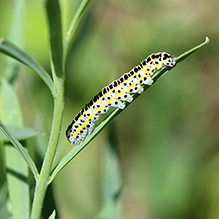 |
|
Another moth … |
… and its larva (on common toadflax) |
|
MinnesotaSeasons.com Photos
|

Slideshows

Visitor Videos
Share your video of this insect.
This button not working for you?
Simply email us at info@MinnesotaSeasons.com.
Attach a video, a YouTube link, or a cloud storage link.
Other Videos
Caterpillar of Toadflax Brocade moth, Calophasia lunula
feathercurls
Calophasia lunula jasnobarvec květelový
Karel Filip

Visitor Sightings
Report a sighting of this insect.
This button not working for you?
Simply email us at info@MinnesotaSeasons.com.
Be sure to include a location.
Gary Walton
6/17/2024
MinnesotaSeasons.com Sightings

